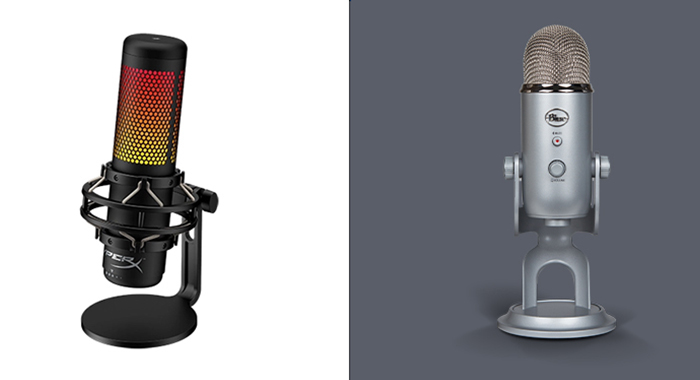
A professional microphone is the best investment you can make when working in digital media, especially when it comes to streaming, podcasting, or voice-overs.
Furthermore, as remote work is becoming more and more common these days, buying a versatile USB mic is now the main priority for most creatives who want to start a new business endeavor.
There’s a wide range of microphones available for beginners and professionals alike. When choosing one, we have countless things to take into account, from the environment we’re recording in, the room set up, and the quality we’re aiming to achieve.
Check out our Best Budget Podcast Microphones Guide.
Today, I want to focus on the two most popular microphones in the market, both beloved by beginner streamers, podcasters, and YouTubers – even for recording vocals and instruments!
We’re talking about the long-time favorite and renowned Blue Yeti and the up-and-coming champion from an awarded gaming brand, the HyperX QuadCast.
The two microphones have been around for some time and are still used and praised by many YouTubers and streamers today.
If you’re looking for a good microphone to start your podcasting career, you’re in the right place! I’ll take you through the specifics of these two amazing products and find out how both can satisfy your needs.
| HyperX Quadcast | Blue Yeti | |
| Frequency Response | 20Hz – 20kHz | 20Hz – 20kHz |
| Microphone Type | Condenser (3 x 14mm) | Condenser (3 x 14mm) |
| Polar Pattern | Stereo / Omnidirectional / Cardioid / Bidirectional | Stereo / Omnidirectional / Cardioid / Bidirectional |
| Sample Rate/Bit Depth | 46kHz / 16-Bit | 48kHz / 16-Bit |
| Ports | 3.5mm Audio Jack / USB C Output | 3.5mm Audio Jack / USB C Output |
| Power | 5V 125mA | 5V 150mA |
| Microphone Amp Impedance | 32ohms | 16ohms |
| Width | 4″ | 4.7″ |
| Depth | 5.1″ | 4.9″ |
| Weight | 8.96oz | 19.4oz |
Let the match HyperX QuadCast vs Blue Yeti begin!
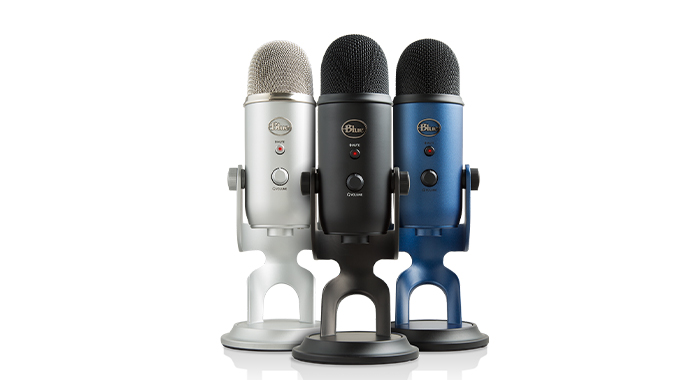
A microphone that requires no introduction, the Blue Yeti is a condenser microphone that’s been around for a decade that everyone working in the audio recording industry loves.
Regardless of whether you’re a podcaster, YouTuber, or sound recordist, you’ll find this dynamic microphone to be the perfect companion for your recording endeavors, thanks to excellent frequency response, zero-latency monitoring, and less background noise compared to the competition.

The Blue Yeti was launched in 2009 by Blue, a brand already known for making excellent microphones. There were not too many USB condenser microphones back then, and the Blue Yeti was the undisputed king for many years.
But what made the Blue Yeti so innovative back then, and what makes it still so valuable after more than ten years?
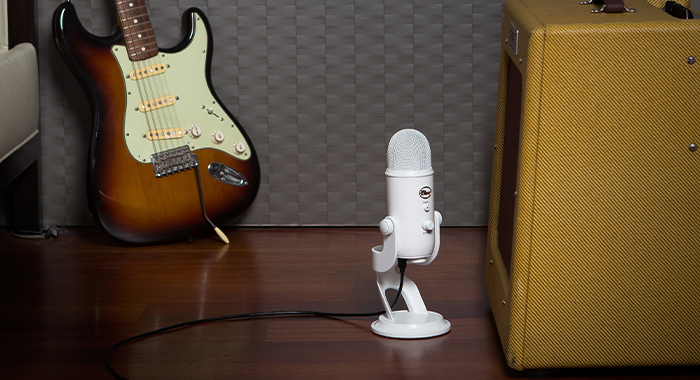
The Blue Yeti is a USB mic that comes with three capsules and four polar patterns to choose from: cardioid polar pattern, stereo, omnidirectional and bidirectional. These microphone pickup patterns give a lot of flexibility to record instruments or vocals for podcasts, voice-overs, and streaming.
Thanks to the USB connection, the Blue Yeti is super easy to set up: just plug it into your PC, and you’re ready to go. Forget about buying interfaces or using phantom power to get it to work.
However, the Blue Yeti does come with some functionalities you might not be familiar with.
For instance, choosing the best polar patterns for your recordings might be difficult at first, but just by using it and trying new settings, you’ll get used to it.
Here’s what comes with the Blue Yeti once you take it out of the box:
It may not seem like much, but this is everything that you need to get started.
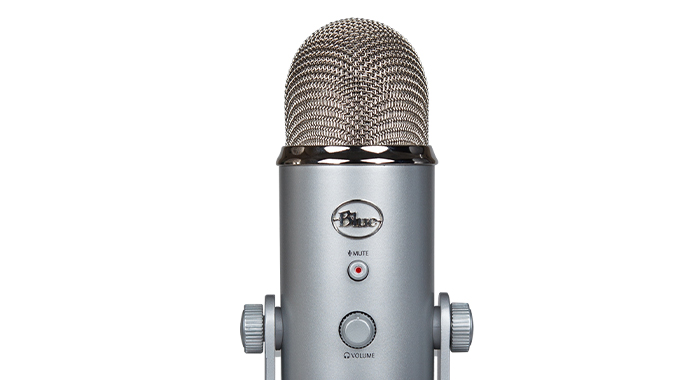
The Blue Yeti is attached to the base by one knob on each side, which is a nice feature because you can move it to adjust it to your height, or if you want a better position to record your instruments, you can do so easily. The stand is detachable, allowing you to mount it to any arm.
The rubber underneath the Blue Yeti will hold it steady on your desk or any surface, and the base will keep it protected if you decide to take it out in your backpack, though it is heavy for travel. On the top, we have the metallic mesh head.
The Blue Yeti doesn’t come with a pop filter, which helps to reduce the plosive sounds that come from letters like P and B when you speak, but I’ll return to this later.
On the body, it has two knobs on the back for the pattern selection and the other for microphone gain, which will help reduce the background noise.
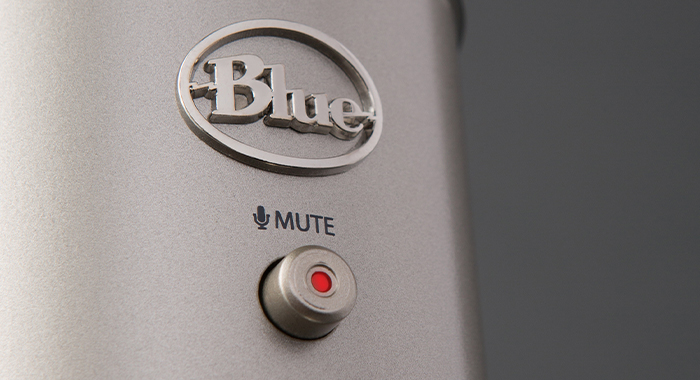
On the front side, the Blue Yeti has a mute button and a headphone volume knob, giving easier volume control when you are recording instead of doing it from your computer.
On the bottom of the Blue Yeti, we find the micro-USB port to connect it to your device.
There’s also a zero-latency headphone output that will allow you to connect your headphones through the headphone jack and listen to what you are recording without delay, meaning you will hear your voice in real time.
With the Blue Yeti, you can download the free VO!CE software which you can use to make the most of your microphone. The software lets you add effects, and professional-grade filters, and equalize audio easily, even if you don’t know too much about equalization.
A great feature about the VO!CE software is that it’s incredibly intuitive and can help the novice navigate through the intricacies of recording audio.
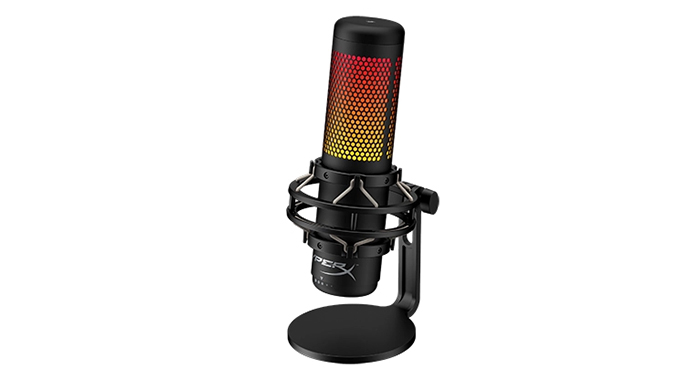
HyperX is a brand specialized in gaming devices like keyboards, mouses, headphones, and most recently, microphones.
The brand started with memory modules and grew its product range in the gaming industry. Today HyperX is a brand known for the quality, aesthetics, and reliability of the products they offer in the gaming world.
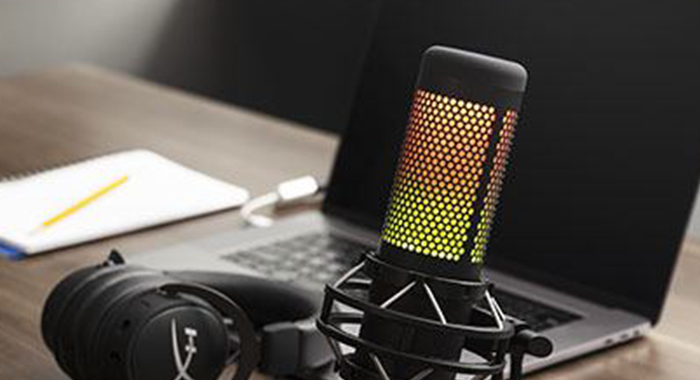
The HyperX QuadCast launched in 2019. It was the first standalone microphone from HyperX, becoming a fierce competitor for the Blue Yeti.
A newer version, the QuadCast S, hit the shelves in 2021.
When HyperX launched the QuadCast, competition in the USB microphone market was already high. Nevertheless, they managed to create an outstanding product that matched the quality of more established competitors.
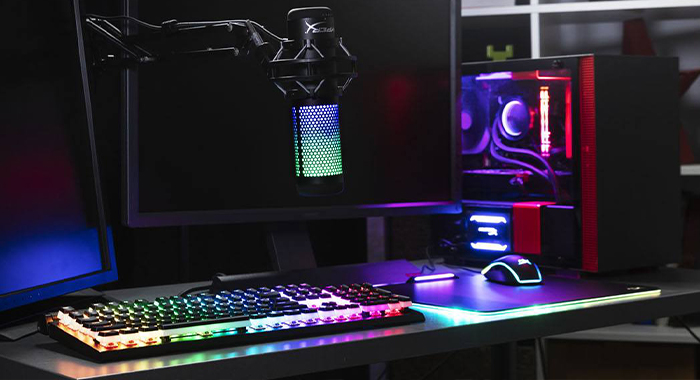
The HyperX QuadCast is a USB condenser microphone. Just like the Blue Yeti, it’s plug and play, ready to start recording or streaming on PC, Mac, and video game consoles like Xbox One and PS5.
It comes with an anti-vibration shock mount, as well as an elastic rope suspension that helps to reduce the low-frequency rumbles and bumps that can affect your audio quality. It also features a built-in pop filter to help soften the plosive sounds.
The HyperX is more than just a microphone for gamers. The mic offers the same four polar patterns as the Blue Yeti: cardioid pattern, stereo, bidirectional and omnidirectional, making it practical for podcasting and professional audio recording.
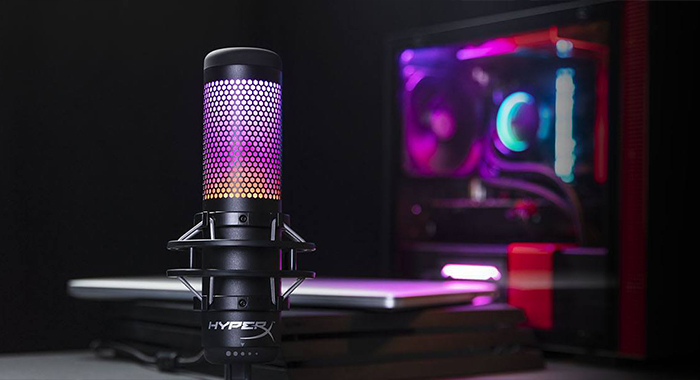
What you will find in the QuadCast box:
It might seem minimal, but that’s all you need to record great audio.
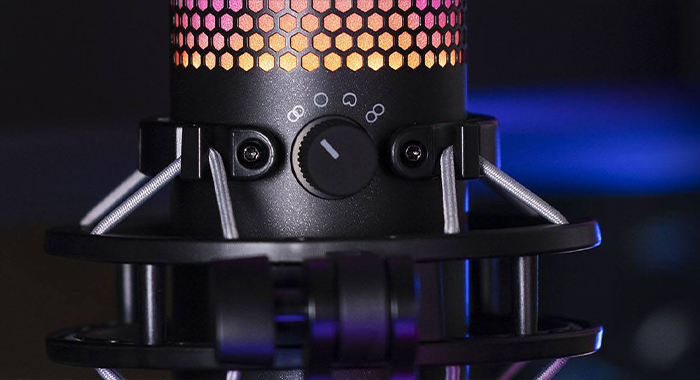
The first thing you’ll see on the top is the mute touch button. One of its best features is it’s easy to mute when you need to pause without affecting your recordings.
Another thoughtful feature is the red LED going off when you mute the QuadCast, and lighting back on when unmuted.
On the back, we’ll find the USB port and headphones jack to monitor your mic in real-time thanks to the zero-latency headphone output. This helps make sure your voice sounds the way you want it to.
Unfortunately, the QuadCast does not include a volume knob for the headphones, but you can still adjust the volume from your computer.
The gain dial is at the bottom to easily adjust the mic sensitivity and control the background noise to help you improve the sound quality.
The mount adapter allows you to use your mic on a different mount or arms to achieve more versatility for your streams, podcasts, or recordings.
The multiple pattern selection is the most common (and perhaps the best) choice for podcasters and streamers who want to achieve broadcast quality sound. In terms of polar patterns, both the HyperX and the Blue Yeti provide great audio quality.
The cardioid polar pattern means the mic will record the sound coming directly from the front of the microphone while mitigating the background noise coming from behind or the sides.
Choosing a bidirectional pattern means the mic will record from both the front and rear sides, a feature ideal for face-to-face interviews or music duos where you can set the mic between the two people or instruments.
The Omni Polar Pattern mode picks up sound from around the microphone. It’s the perfect choice for situations where you want to record multiple people, like conferences, group podcasts, field recordings, concerts, and natural environments.
The last of the polar patterns, the stereo pickup pattern, captures sound from the right and left channels separately to create a realistic sound image.
This option is perfect when you want to create an immersive effect for your acoustic sessions, instruments, and choirs. This option has become very popular among ASMR microphone lovers on YouTube.
In terms of sound quality, the Blue Yeti and the QuadCast are comparable. Some users state that Blue Yeti picks up the voice warmly, but they both deliver exceptional quality for an affordable price.
As you can see, you have unlimited options for recordings with both the Blue Yeti and the QuadCast. They’re both USB microphones, so you don’t need to worry about extra hardware, and both are compatible with PC, Mac, and video game consoles.
Now let’s get to the nitty-gritty of this competence. Where does the Blue Yeti differ from the QuadCast?
First of all, the HyperX QuadCast has a compact design compared to the thick stand of the Blue Yeti. You can place the QuadCast around in any environment, while the Blue Yeti is undoubtedly bulkier.
The addition of the shock mount and pop filter in the QuadCast gives the impression of having a complete recording package.
If you work with a condenser mic, you need an external pop filter since they tend to capture more subtle frequencies, and the shock mount will prevent accidental sound when moving your mic or bumping into it.
While the QuadCast has a more accessible gain dial on the bottom and a mute touch button, the Blue Yeti has better access to most of the knobs and the 3.5 headphone jack than the QuadCast.
The Blue Yeti VO!CE software will let you enhance your audio even if you don’t have experience in equalization: just by playing around with the filter, you can get decent quality. Something the HyperX counterpart does not offer.
The final stage is price. And this will depend on the time you’re reading this, as both microphones occasionally are on sale, but according to their official websites, the standard price for the Blue Yeti is $130, and $140 for the HyperX QuadCast.
Let’s wrap up the “Blue Yeti vs. HyperX” match with a comparison of their best features. With what you know now, all that’s left to decide is whether you should pick the all-included HyperX QuadCast or the long-time favorite Blue Yeti.
You should opt for the HyperX if you’re looking for good sound quality without having to set up extra hardware or play around with the sound too much.
Thanks to an accessible mute button and a compact design, it’s easy to change from stand to arm, and you don’t need to spend on additional equipment like a mount adapter, shock mount, or pop filter.
For $140, you’ll find in the HyperX the perfect go-to microphone that will meet your needs for a long time.
If you prefer easy access to knobs and buttons, a built-in headphones volume knob, a more professional design to upgrade your setup, and easy-to-use software to get the best sound quality from it, then the Blue Yeti mic is your best choice.
As you may realize, it all comes down to functionality, design, and how you’re going to use this USB mic. If you’re not recording voices, you probably don’t need to add a pop filter to your Blue Yeti.
However, if you’re moving it around or recording close to it with the instruments, you might want to consider getting a shock mount.
It’s safe to say that the HyperX QuadCast is a better option if you want to have everything you need the moment you take it out of the box without compromising on quality or investing in a professional microphone.
Even though the QuadCast was launched ten years after the Blue Yeti, the fact these two microphones are still competing proves the quality of the Blue Yeti.
The Blue Yeti has been the industry standard for podcasters, game streaming, and indie musicians for many years, which speaks volumes about the quality and versatility of this incredible USB microphone.
This USB microphone first made a name for itself as a gaming microphone and then became one of the must-have items in the recording studios of professional podcasters and YouTubers.
If you’re looking for a USB microphone that doesn’t break the bank and still provides close-to-professional results, then look no further than the HyperX Quadcast.
The reason why it’s convincing so many audio creators is because of its versatility, transparency, and ease of use. It may not provide you with the peerless audio quality of a professional condenser mic, but the HyperX Quadcast is undoubtedly an excellent starting point for audio creatives of all kinds.
The captivating design, versatility, and intuitiveness of the HyperX Quadcast make this USB microphone the winner of the day. Although both microphones are phenomenal for the price, the HyperX Quadcast feels somehow more capable when it comes to recording in non-professional environments.
With the built-in shock mount, the mute button, RGB lighting, and built-in pop filter, combined with a much lighter weight than the Blue Yeti, the Quadcast feels more like a recording companion than its iconic counterpart.
That said, the Blue Yeti is a fantastic microphone and one of the most popular among audio creators, hands down.
The Blue Yeti’s popularity is based on solid ground: incredible frequency response, reliability, durability, and professional recording quality in most environments are only some of the features that made this microphone legendary.
However, the Blue Yeti is also big and heavy, making it uncomfortable for recordists who spend a lot of time outside the recording studio or moving the microphone around to capture the best sound.
If you’re planning to place your microphone somewhere and not move it from there at all, then both microphones will satisfy your needs. However, if you’re looking for a USB mic to travel with, I’d suggest you go for the counterpart.